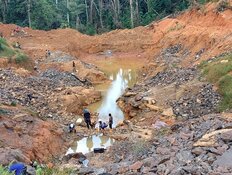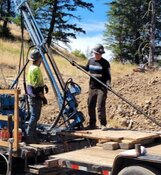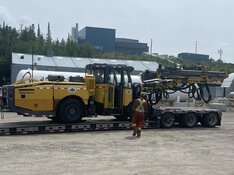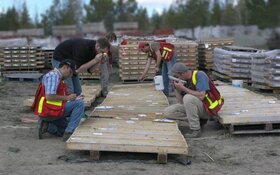The Gold Report: Gold rose to $1,200 per ounce ($1,200/oz) Nov. 21 and has stayed close to that price since. Is this evidence of the end of the bear market?
Chris Ecclestone: It's evidence of a bump upward in gold. The rise has not been so robust that one would be persuaded the tide has turned.
TGR: What's your opinion of the hypothesis that there is an organized shorting campaign to bring gold down to $1,000/oz?
CE: I don't believe it. Gold is being pushed around on pretty low volumes by buyers and sellers. The Indian trade isn't what it was. Western buyers are just not there anymore, particularly large speculative buyers.
TGR: The Toronto Stock Exchange has had recent highs led by mining stocks. Are we seeing a recovery in precious metals equities?
"Galane Gold Ltd. is the horse that Samsung is betting on."
CE: There's an outsized correlation between the gold price and gold equities. Gold will drop 5%, and then gold equities drop 20%, but it's not so sticky on the way back up. Investors have seen over and over again that being a first mover on gold equities is not worth the effort.
TGR: Why has the gold price fallen so precipitously?
CE: People are just not feeling inflationary at the moment. Quantitative easing (QE) is being tapered, and the money supply apocalypse has not occurred. Exhaustion eventually sets in when the same old argument keeps being trotted out and proved wrong.
TGR: What about the trillions of dollars in new money created since 2008?
CE: Much of it is being sterilized and recycled and has gone off to other places. The gold bulls talk about the printing presses being run endlessly, but what has happened since 2008 in the West is not comparable to what happened in Zimbabwe in 2008 or Germany in the 1920s. This isn't funny money. It's still owed to the government and will have to be repaid.
"Atna Resources Ltd. is almost all blue sky now."
QE consisted of the U.S. government loaning money to banks. The banks loaned it to hedge funds that then put it into emerging markets. One of the reasons why markets like Brazil have been so floppy over the last year is the carry trade is over, and the money is coming back to the original borrowers. They, in turn, are flipping it back to the Federal Reserve or into the U.S. equity markets, which after a brief hiccup are again ebullient. At least it's not going into the U.S. property markets again, which is a good thing because that bubble is not with us anymore.
TGR: You stress the importance of mining jurisdictions. Which jurisdictions once thought mining friendly are no longer so?
CE: Chile was a great favorite for years, but it now has some black marks against it. Yamana Gold Inc. (YRI:TSX; AUY:NYSE; YAU:LSE) has been hit with a new levy described as a noncash tax charge. How can you have a tax charge that's noncash? It either is or isn't, particularly when levied retroactively.
Barrick Gold Corp.'s (ABX:TSX; ABX:NYSE) problems with Pascua-Lama are much more than a simple capital expenditure (capex) blowout. Capex exploded because the process took a lot longer than expected on the Chilean side, not the Argentinean side. Then there's the water problem. Many Chilean projects at whatever capex cannot get water because it is needed at lower altitudes to service the urban areas.
Mexico has been a happy hunting ground for Canadian miners over the last 10–15 years. When I was based in New York, investors would ask about the cartels. They were told not to worry because they weren't active in mining areas, only in Tijuana. That's now been dispelled as a myth.
TGR: How is the mining industry dealing with this threat?
CE: I went to a presentation recently where a company said it was employing people to maintain good relations with the cartels. This sounds like skating on the thin ice of the international anticorruption rules. The miners are not paying off the government but paying off some gangsters threatening to blow up their mines or roads unless they employ some of their factotums as a security force.
Then there's the issue of royalties. We heard for years that they would never rise in Mexico. Well, after 10–15 years of the country being open for mining, the government had not realized the increased revenues it expected, so it decided to squeeze more juice out of that lemon.
TGR: Which jurisdictions have become more mining friendly?
CE: One that potentially could surprise Canadian miners is Bolivia. It has been in the dog house for a long time because of one or two incidents. Another is Cuba. Frankly, Cuba has been mining friendly, it's just that people haven't been willing to admit that companies like Sherritt International Corp. (S:TSX) have had a pretty good run there.
TGR: Are you expecting a big increase in mergers and acquisitions?
CE: Bargain hunting has been going on for a while, and I think we'll see more. In the past, takeover targets demanded a 200–300% premium to the current market price. Now they're so desperate they will be taken over at whatever price. We saw this recently with Duluth Metals Ltd. (DM:TSX) taken over for a song by Antofagasta Minerals Plc (ANTO:FSE) because Antofagasta had Duluth over a barrel.
TGR: What type of companies are likely targets?
CE: Juniors with companies with unfinanceable projects, basically anything over $500M. A good example is Chesapeake Gold Corp. (CKG:TSX.V) and its $4 billion, 18.5 Moz gold Metates project in Mexico. Goldcorp Inc. (G:TSX; GG:NYSE) owns about 9% of Chesapeake, and only Goldcorp has the money to finance Metates. This is too rich for Agnico Eagle Mines Ltd. (AEM:TSX; AEM:NYSE) or even Yamana Gold Inc. (YRI:TSX; AUY:NYSE; YAU:LSE).
Majors such as Goldcorp, Newmont Mining Corp. (NMC:TSX; NEM:NYSE) and Barrick Gold need to plug holes in their future production, and only companies of this size can realize projects such as Metates.
TGR: The majors have their own bottom line problems. How can they pay to take on new assets?
CE: I think they'll pay with shares. Their takeover targets will be able to justify cheap sellouts to their shareholders by pointing out that cash payouts would be derisory, and the buyers will not want to dilute their shares; they need their cash to develop their new properties. They can tell the shareholders that by taking the shares, if the acquisition works out, one plus one will not equal two but rather three, four or five.
With regard to base metals takeovers, I believe that the zinc story is going to lift off. There are now no properties in the development stage owned by small companies. That means the projects that will be acquired by the majors such as Lundin Mining Corp. (LUN:TSX) will be in much more formative states.
TGR: Do you see base metal prices rising in the near term?
CE: I think nickel could go up despite the Chinese putting on a brave face about the Indonesia shutdown. If copper trades above $3 a pound ($3/lb), it's a good place to be. Everybody's profitable. I'm really bullish about zinc, which I think could break through $1.20/lb in the first half of 2015 and then perhaps rise above $1.50/lb. That would be a pretty massive move from the $0.80/lb where it was wallowing a few months ago.
TGR: Gold and silver, where do you see them going?
CE: I wouldn't be surprised to see silver remaining between $15/oz and $18/oz. I don't see gold going much above $1,300/oz in the near future. Declining production will underpin the future gold price. The gold production trend was up slightly over the last decade, but now the big mines in South Africa are pretty much finished, and it's much harder to get grade in new gold mines.
TGR: You've written that brownfields projects "trump" greenfields projects. Why?
CE: Basically the work's been done already. We know that there's something there and that it's mineable. In many cases, juniors don't have the money to pay for preliminary economic assessments (PEAs) or preliminary feasibility studies (PFSs). And if they don't have the money for that, then what's the point of drilling to make the resource bigger? In any case, we all know the market tends to hit stocks that come out with larger resources because that indicates the companies must move on to PEAs and PFSs they can't afford. Those projects are stuck.
TGR: Is there a way out?
CE: A number of companies have recently been looking at old mines with historic resources. These used to be treated like the old aunt hidden in the attic. Now the attitude is even though they are not NI 43-101 compliant, these resources were calculated to a very high standard by companies like BHP Billiton Ltd. (BHP:NYSE; BHPLF:OTCPK) and Noranda. We're not talking about Bre-X here. If the historic resource is reliable, why shouldn't companies mine projects on that basis?
Another advantage of historic resources from shuttered mines is that they were calculated day-by-day as the mine moved forward. These are not theoretical blobs supposedly under the ground. These are real deposits that were really being exploited. These mines have ramps and adits, all sorts of infrastructure. Even if all the equipment has been removed from aboveground, having roads, electricity hookups and water constitute significant savings that you just do not get with greenfield properties.
TGR: What current producers are you following?
CE: One is Galane Gold Ltd. (GG:TSX.V), which is producing from its Mupane mine in Botswana. It's trading at $0.195, and its market cap is actually lower than its cash on hand. The company's high cash cost was inherited from previous owner IAMGOLD Corp. (IMG:TSX; IAG:NYSE), which wasn't particularly concerned with costs from lower-producing mines. IAMGOLD just wanted the ounces.
Over the past two years Galane has gotten its cash costs down to about $1,100/oz. The company is working to bring costs down further by shifting to production from stockpiles, from unworked tailings, at about $700/oz. Investors are not yet up to speed on this, as they are too concerned with the companies in their portfolios that have lost 75%.
TGR: Galane has signed an offtake agreement with Samsung Electronics Co. Ltd. This is the first such agreement I've heard of. Why has it done this?
CE: Galane has done this to get a nice cushion of cash, about $5M. Samsung has done this because it is one of the world's largest industrial consumers of gold through its production of cell phones and other devices. Samsung is a pretty smart organization, and it's fascinating that Galane is the horse it's betting on. I think we'll see a synergistic relationship between these companies in the future. Should Galane find another project and is considering adding 100,000 oz per year of production, its first call will be not to Bay Street but to Seoul.
TGR: You have a 12-month target price for Galane of $0.90.
CE: I know it's a pretty rich target, but if investors realized this stock's discount to cash, it would have the potential to rise 20–25% above the cash value. The bigger change will come when investors realize that production has become profitable. The $100/oz profit on Galane's stockpiles lowers the average cost of every ounce it produces. This combined with so few shares issued and such a low market cap equals an exponential move.
TGR: Now, you follow another low-valued gold producer, don't you?
CE: Yes, Atna Resources Ltd. (ATN:TSX), which is producing from its Briggs mine in California. It's trading at $0.065, which is crazy.
TGR: The company also has the past-producing Pinson project in Nevada, which has a $67M capex. What do you think of Atna's prospects?
CE: It always seemed to have too many projects, but it recently sold two in Nevada for $10M. Focusing on Briggs and Pinson is the way forward for Atna. I suspect that it will do a deal with a royalty company or make some other kind of arrangement to get Pinson going. It will probably have to sell its soul and mortgage its properties to whomever its funder is, but this stock is so battered after its mistakes of the past that it's almost all blue sky now.
TGR: You follow another company with what we might call a "microcapex" project. Tell us about it.
CE: Minnova Corp. (MCI:TSX.V), which changed its name this year from Auriga Gold. This is a good example of what I was saying about shuttered mines with historic resources. Its Maverick gold project in Manitoba still has its entire underground infrastructure and most of the aboveground as well. Its all-in capex is only $29.5M, and it has a 55% after-tax internal rate of return, so it might get snapped up by a midtier even before it goes into production. The stock is trading at $0.345, and our 12-month target price is $1.13. Another thing in Minnova's favor is that it's in Manitoba.
TGR: Why is that significant?
CE: For years we've heard that Quebec is the best jurisdiction in the world and about the advantages of Ontario and British Columbia, but Manitoba is really hot now. So much is going on there. It used to be only HudBay Minerals Inc. (HBM:TSX; HBM:NYSE) sort of struggling along with its base metal mines. But HudBay is expanding. And VMS Ventures Inc. (VMS:TSX.V) is another example of what can be achieved in that province. Manitoba has a good mining regime and doesn't have the problems you get now in British Columbia.
Minnova is in a position where permitting should be easy. The process can actually be sped up because for governments to drag their heels on a mine that was operating until fairly recently would look pretty childish.
TGR: You've acted on your own advice regarding past-producing mines, yes?
CE: That's right. I'm the president and CEO of Geodex Minerals Ltd. (GXM:TSX.V), which has two historic antimony-gold projects, West Gore in Nova Scotia and Jacaranda in Spain. Our goal is to reactivate them. Jacaranda is an open-pit mine that was producing up until the 1970s. We are doing some elementary exploration because it's not such a big pit, and most of the deposit is near the surface. West Gore produced between the 1880s and the 1920s.
TGR: Is there a final brownfields project you could talk about?
CE: Avalon Rare Metals Inc. (AVL:TSX; AVL:NYSE; AVARF:OTCQX) is an interesting story because it is reviving the East Kemptville tin mine in Nova Scotia. This mine was owned originally by Rio Algom, which was bought by Billiton, which became BHP Billiton. This is another example of a project where the research was done by majors, so Avalon knew what remained of the resource and how much was in stockpiles and near the tailings. This has saved the company a lot of effort and made it much easier to plan its future.
TGR: Heading into 2015, what should investors in the gold space be looking for in companies?
CE: Production and past production. Production is kingly, and past production is princely. Anything else, stay away.
TGR: Chris, thank you for your time and your insights.
 Christopher Ecclestone is a principal and mining strategist at Hallgarten & Company in New York. He is also president, CEO and a director of Geodex Minerals. He was previously head of research at an economic think tank in New Jersey, founder and head of research at the Buenos Aires Trust Company and a corporate finance and equities analyst and freelance consultant on the restructuring of the securities industry in London. He holds a degree from the Royal Melbourne Institute of Technology. Ecclestone is an author at InvestorIntel.
Christopher Ecclestone is a principal and mining strategist at Hallgarten & Company in New York. He is also president, CEO and a director of Geodex Minerals. He was previously head of research at an economic think tank in New Jersey, founder and head of research at the Buenos Aires Trust Company and a corporate finance and equities analyst and freelance consultant on the restructuring of the securities industry in London. He holds a degree from the Royal Melbourne Institute of Technology. Ecclestone is an author at InvestorIntel.
Read what other experts are saying about:
Want to read more Gold Report interviews like this? Sign up for our free e-newsletter, and you'll learn when new articles have been published. To see a list of recent interviews with industry analysts and commentators, visit our Streetwise Interviews page.
DISCLOSURE:
1) Kevin Michael Grace conducted this interview for Streetwise Reports LLC, publisher of The Gold Report, The Energy Report, The Life Sciences Report and The Mining Report, and provides services to Streetwise Reports as an independent contractor. He owns, or his family owns, shares of the following companies mentioned in this interview: None.
2) The following companies mentioned in the interview are sponsors of Streetwise Reports: Galane Resources Ltd. and Atna Resources Ltd. Goldcorp Inc. is not associated with Streetwise Reports. The companies mentioned in this interview were not involved in any aspect of the interview preparation or post-interview editing so the expert could speak independently about the sector. Streetwise Reports does not accept stock in exchange for its services.
3) Christopher Ecclestone: I own, or my family owns, shares of the following companies mentioned in this interview: Geodex Minerals Ltd., of which I am president, CEO and a director. I personally am, or my family is, paid by the following companies mentioned in this interview: Geodex Minerals Ltd. My company has a financial relationship with the following companies mentioned in this interview: Galane Gold Ltd. I was not paid by Streetwise Reports for participating in this interview. Comments and opinions expressed are my own comments and opinions. I determined and had final say over which companies would be included in the interview based on my research, understanding of the sector and interview theme. I had the opportunity to review the interview for accuracy as of the date of the interview and am responsible for the content of the interview.
4) Interviews are edited for clarity. Streetwise Reports does not make editorial comments or change experts' statements without their consent.
5) The interview does not constitute investment advice. Each reader is encouraged to consult with his or her individual financial professional and any action a reader takes as a result of information presented here is his or her own responsibility. By opening this page, each reader accepts and agrees to Streetwise Reports' terms of use and full legal disclaimer.
6) From time to time, Streetwise Reports LLC and its directors, officers, employees or members of their families, as well as persons interviewed for articles and interviews on the site, may have a long or short position in securities mentioned. Directors, officers, employees or members of their families are prohibited from making purchases and/or sales of those securities in the open market or otherwise during the up-to-four-week interval from the time of the interview until after it publishes.










































